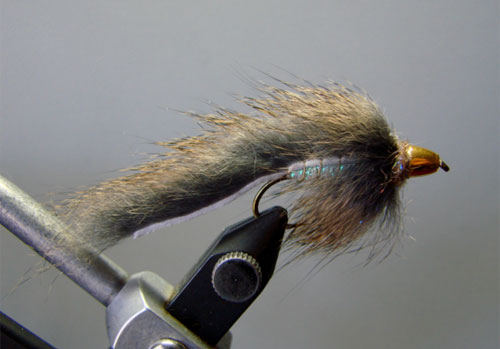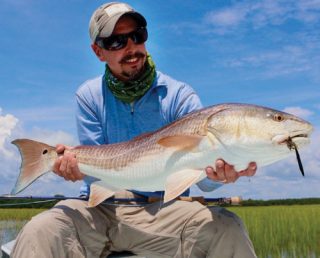By: Dustin Stanberry

After securing the tail (wing) of the fly, tie in your copper wire rib and flat braid body. Wrap the flat braid forward creating a slightly tapered body and secure about half the length of the cone behind the bead. Lay your zonker strip directly on top of the body and secure just in front of the body, do not trim the excess yet. We will use it for the body of the fly. Now comes the tricky part, spiral wrap the copper wire through the zonker and try not to catch too many fibers while doing so. Secure the wire just in front of the zonker and trim away the excess. Now we can take the excess zonker and wrap it, palmer style, to just behind the conehead bead. Be sure to keep the fibers lying back toward the hook bend as you wrap forward and keep those wraps fairly tight. Sometimes I will add super glue to the area I am wrapping over just to lock things in place. Once you have met the conehead, you can secure the zonker and trim away the excess. The fly is now complete. If you wish, you can add one more additional step and place a small amount of dubbing just behind the bead and whip finish. (Tip: If you are having trouble controlling the zonker fibers, use a little bit of water to lay the fibers down and keep them out of the way.)
This is the way I tie Barr’s Slumpbuster Streamer. It can be tied in many different color configurations and on several hook sizes. I tend to keep this fly in the smaller streamer sizes like 8-12. If you notice that you are getting a lot of short strikes, the tail length can be trimmed on the water with a pair of scissors or snips. If the fish seem wise to the brass conehead, the color can be changed with a permanent marker as well. You can also tie the fly with different color conehead beads as well. It’s a fairly simple pattern to tie and is very effective. With spring, hopefully around the corner, we may see water levels begin to rise and fall and some of the bigger trout starting to move around and feed a bit more actively. With this in mind, having the streamer box stocked and handy is a great idea. This is a fly pattern that can easily be thrown with lighter line sizes if need be and the tungsten conehead helps to get the fly down deep. It works great for stocked trout as well as educated fish. Tie up a few and give them a go. As always, best wishes and tight lines!
Hook: Tiemco #300, Size 10
Bead: Small Tungsten Conehead-Brass
Thread: UNI-Thread 6/0, Camel
Wing: Micro Pine Squirrel Zonker, Natural
Rib: Medium Copper wire
Under Body: Orvis Pearlescent Flat Braid, Pearl
Body: Micro Pine Squirrel Zonker, Natural
Dubbing: Senyo’s Laser Dubbing, Tan
(This step is optional.)
Dustin Stanberry is an instructor at Biltmore Fly Fishing and Sporting Clays located in Asheville, NC.

